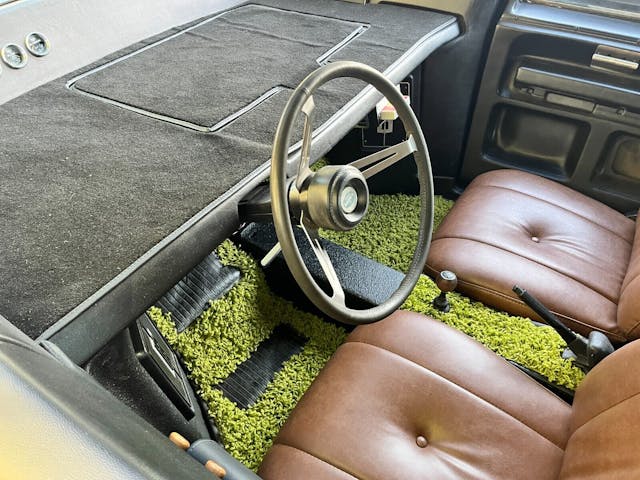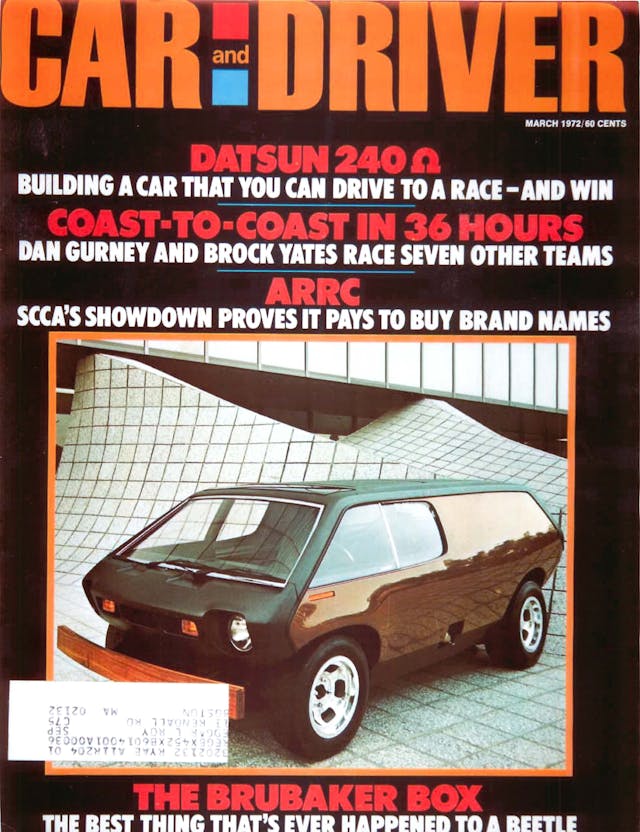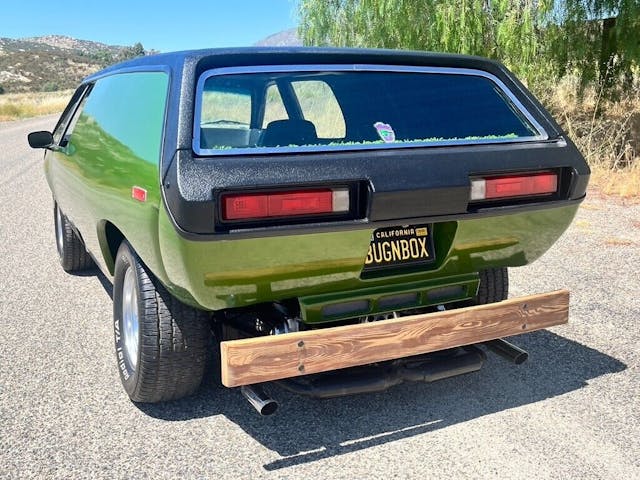Why an oddball ’70s surf van just sold for $68,900
One of only 25 Brubaker Boxes—essentially kit cars built on Volkswagen Beetle chassis—recently sold on eBay for an astounding $68,900 (plus taxes and fees), but Hagerty Price Guide publisher Dave Kinney isn’t surprised at how much money the fully restored example brought. He owned one himself, in the 1970s.
“I think the good news for somebody is if [Brubaker Boxes are] selling for sixty-eight nine, then you should go make some molds, get some old VW chassis, and you’re in business,” Kinney jokes. “Seriously, that’s a lot of money, but good luck finding another one. They just aren’t out there.”

Kinney understands the draw of the Bug-based Box, which he says is arguably the first minivan. “It was a big sensation because it was on the cover of Car and Driver [in March 1972],” he says. “It was a completely new concept, and it made a big splash. People would stop and stare at it. It was really, really, really mind-boggling.”

The Box was the invention of California inventor Curtis Brubaker, who studied car styling at Pasadena’s Art Center College of Design and worked for Lear Jet and General Motors before setting up his own design studio in Los Angeles. He created dozens of innovations over the years, including the 8-track tape player while working with Bill Lear. Brubaker envisioned the Box as a tool for surfers to get their boards, gear, and friends to the beach.
As Brubaker explained to the Galpin Auto Sports team on Discovery UK’s G.A.S. Extreme Customs in 2020, it all started with the theft of his brother’s VW van. “I was thinking, ‘Why is this guy stealing a used Volkswagen?’ And we got to thinking about all the surfer kids driving these things. We took a trip down to Newport Beach; I took one picture where there were like seven or eight of ’em on one tiny street, and I said, ‘There’s a market here … something that appeals more to the kids.’”
Brubaker debuted the prototype Baha Box at the 1972 Los Angeles International Motorsports Show and gained enough funding to start production, but Volkswagen refused to sell him any chassis. That meant he’d have to buy new Beetles and remove the bodies, which proved too costly and time consuming. Three concept vehicles were built before Brubaker sold the design to Mike Hansen’s Automecca of Chatsworth, California. Most sources agree that Automecca, which offered the vehicle as the Sports Van, built 25 in total, including the one that just sold on eBay.
The innovative one-box van—fashioned with 13 fiberglass panels mounted on a stiff tube frame and attached to the Type 1 chassis—features sloping front and back glass, a removable roof, and a single sliding door on the passenger side. To keep costs down, the windshield was borrowed from an AMC Hornet and the rear glass came from a Chevrolet El Camino. Although there is debate about whether the bumpers were made of wood or a composite material, Kinney says they were wood: “Two slabs of wood, front and back.”

In addition to the VW’s driver and passenger seats, the rear seating was “essentially a tan, vinyl-covered couch,” Kinney says. The love seat could be removed to add cargo space.
The Brubaker Box stood only 53 inches tall, which made it an adventure to get in and out of. “You had to step into it from the side and walk to the drivers’ seat while stooping over.”

Kinney bought a brown metallic Brubaker Box/Automecca Sports Van in 1977 after hearing about it from a friend who owned an auto dealership near Fort Lauderdale. He traveled to Florida from Virginia to check it out. “I remembered it from when it was on the cover of Car and Driver,” Kinney says. “I bought it without really knowing any of its (individual) history, as you did back then. I think I paid $3000 for it and sold it 18 months later for $4000.
“I drove it for at least a year—used it as a daily driver in the summer, and boy, was it hot in there. The driver- and passenger-side windows slid back, and it was hard to see out the back and the sides. It wasn’t the most practical car; it was a totally enclosed dune buggy. It had a VW semi-automatic transmission, which never worked properly. If I’d kept it, I would have swapped that out.”

With that said, “It was really fun, and pretty well-made in that I never had a problem with anything falling off. It was a good-looking little truck. I wish I knew what happened to mine. I hope it’s still out there somewhere.”
Last week, when we wrote about the Jungle Green Metallic 1971 Bug-based Brubaker Box/Automecca Sports Van offered on eBay, readers wondered where the surf boards were intended to reside, inside or outside, since the roof was removable and there was no rack. Kinney says it was an easily solved problem.
“You’d just buy a universal roof rack from the Sears catalog and strap the boards on top,” he says, then adds, “Don’t ask about my surfing skills, because they’re non-existent.”

While Kinney jokes that the nearly $70K paid for the Box/Sports Van on eBay should motivate someone to start building them again, California entrepreneurs Tomo Bullum and Dale Davis are way ahead of him. Four years ago, Bullum and Davis announced plans to launch a vehicle inspired by the Brubaker Box, but they have not yet responded to inquiries through their website.
If their plan comes to fruition, would Kinney consider buying one?
“Nah, I’ve been there, done that,” he says. “They’re great to own, but they aren’t great to drive.”
One lucky bidder is about to find out.
***
This article first appeared in Hagerty Drivers Club magazine. Click here to subscribe and join the club.



“8-track cassette player”?
Yes, Brubaker referred to Lear’s idea as “a sealed cassette that you never had to rewind,” but I don’t think he called it an “8-track CASSETTE player.” Did he?
Yes, they were refereed to as 8 tack. Earl “Madman” Muntz pioneered the cartridges with a four track system. The Lear system doubled the tracks and convinced the car makers to make them available in their new models. I did a piece for Motor Trend Year book about the differences. The next leap in car audio was the ubiquitous cassettes, which could be recorded on, spurring the home made mix tapes, as well as prerecorded commercial ones
used in the Sony Walkman and other music devices.
There was an interesting conversation regarding this sale on Barn Finds. I pulled this from the conversation:
the molds are being restored in california. they were in Florida for a time. then went up to a Connecticut barn. the barn caught fire and for years the molds were thought to be destroyed. at some point before the fire, they were removed and thrown under a bridge overpass, where they were completely overgrown with years of vegetation until they were accidentally re-discovered.
https://barnfinds.com/rad-rarity-1971-brubaker-box/?unapproved=1355693&moderation-hash=a5a83d7ba30e5f9f8a670a55ef39ed94#comment-1355693
Great stuff! Thanks for sharing.
It’s weird. I bought a V8 Lexus IS500 for less than this. It seems like one zero too many.
Agreed!
I Have been looking for one of these for over 40 years. I am glad it is being restored.
I think any short wheel base scaled down van would sell well here. (If the price is right). But no chance of that! They even forced the giant I.D.BUZ onto us with a longer “full sized” version. I think small vans and trucks could dominate the market if made available. Especially small trucks. The price for this van seems crazy to most folks but I can understand why someone would do it.
The bumpers are indeed fiberglass, not wood…and you can’t really put a surf rack on the top as there are no gutters to clamp to and the sliding door would interfere with anything you put there anyway.
Such a great design visually, but such an awkward one to live with. As much as I would love to see them come back, after restoring and driving this one, the reason so few were sold are obvious.
The discovery, restoration and now the sale have been an incredible trip for me. Thanks Hagerty for sharing the fun and of anyone wants to see the process, it’s on YouTube !
Thank you, Randy! Appreciate the info; thanks for putting this out there. It’s a fascinating “van” and story!
we at DRIVEN.CO are in the midst of restoring a couple of Boxes and finalizing repairs to the original molds in conjunction with our updated molds for the Box. all this is no small, nor inexpensive task. we would love to expedite all our efforts and get Box body kits onto the marketplace. the Box needs to be available to the public, and we strive to arrive at that goal every day. the green Box was both well sold, and well bought. the Box interest never wanes.